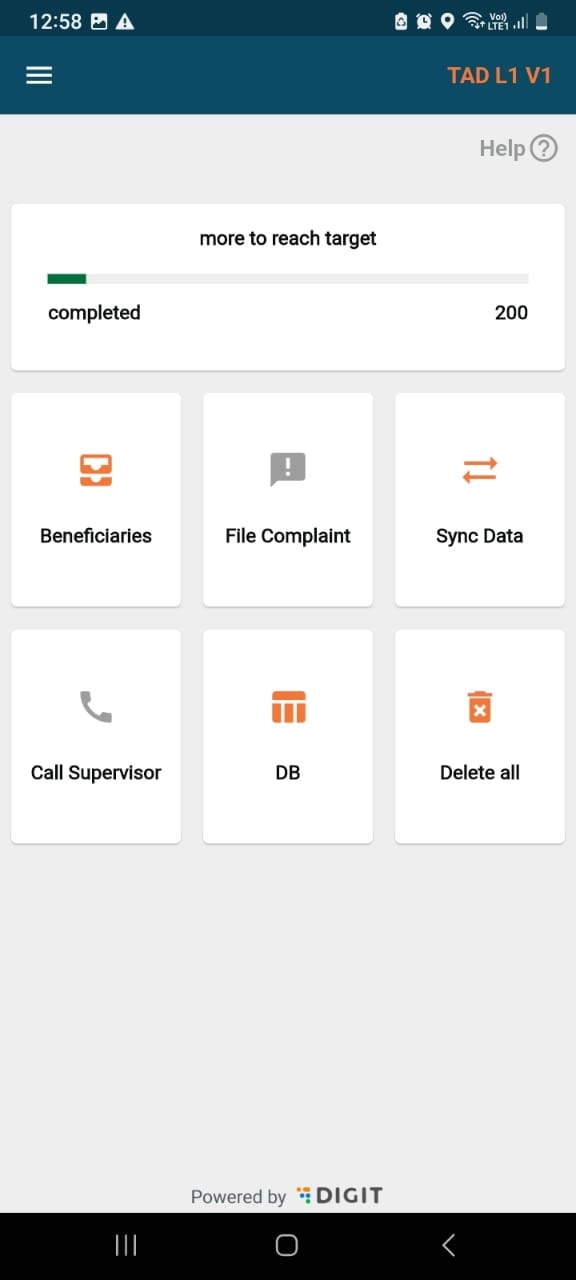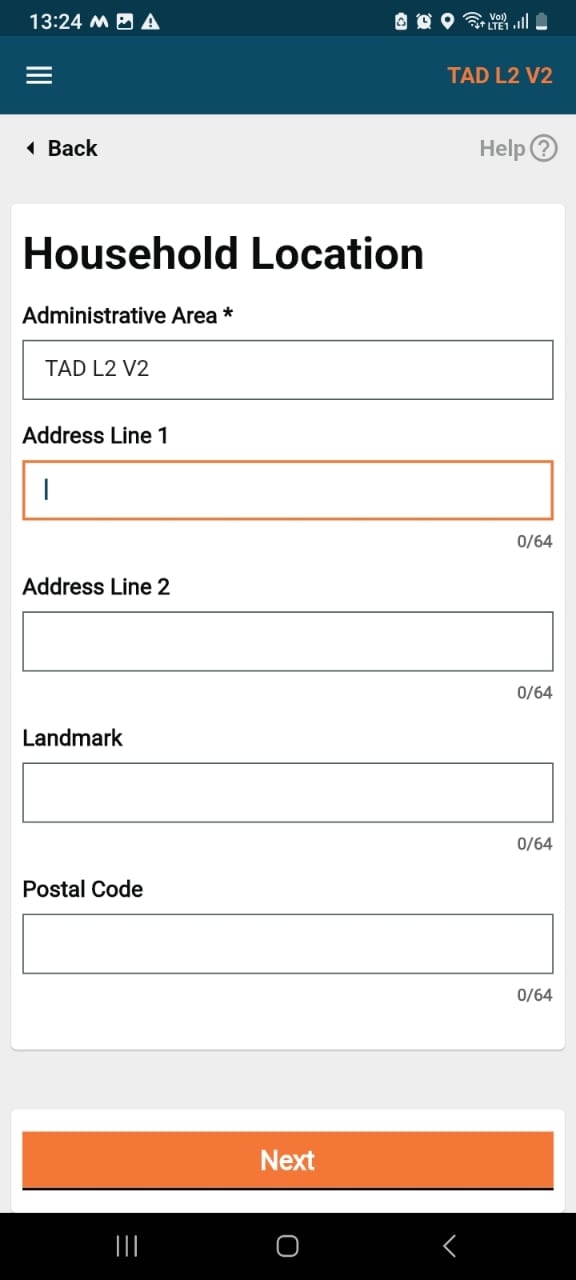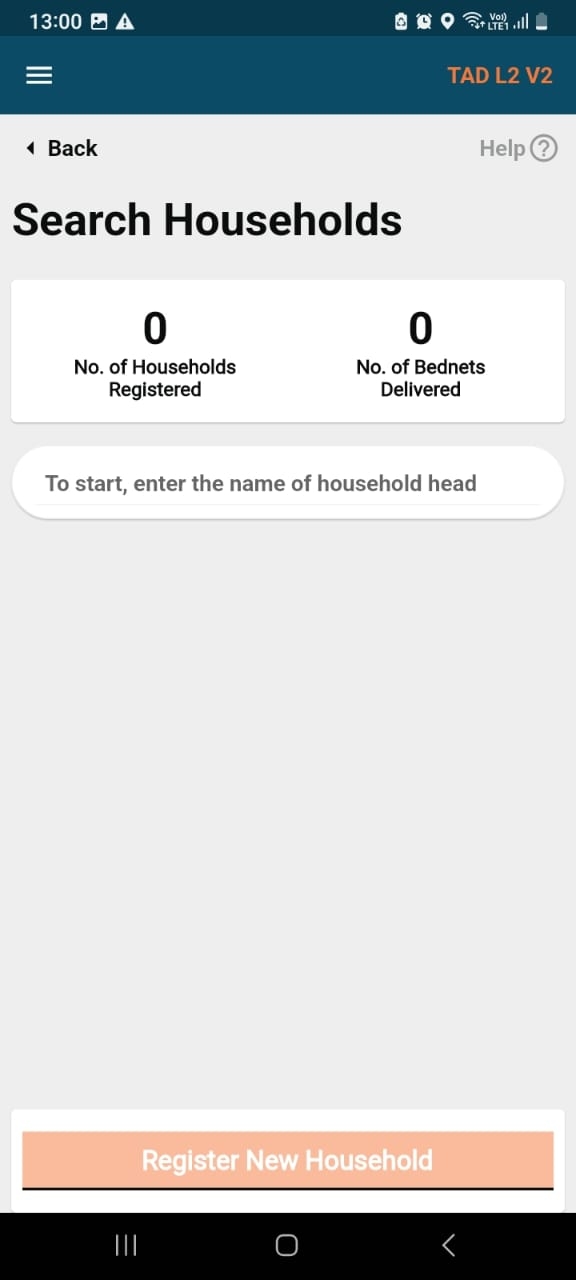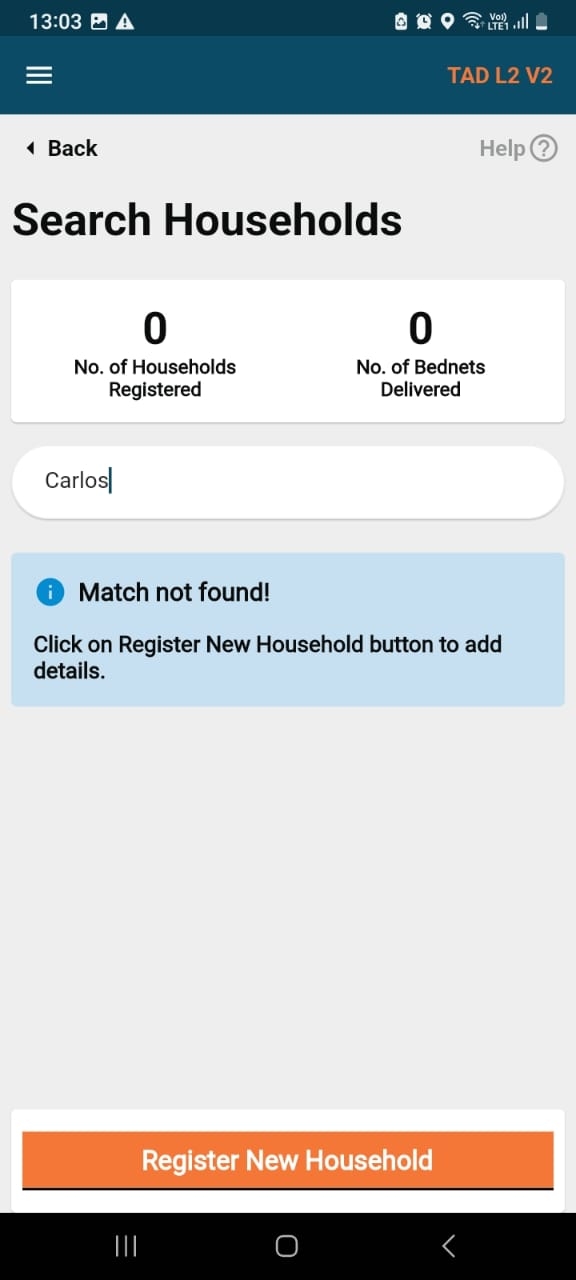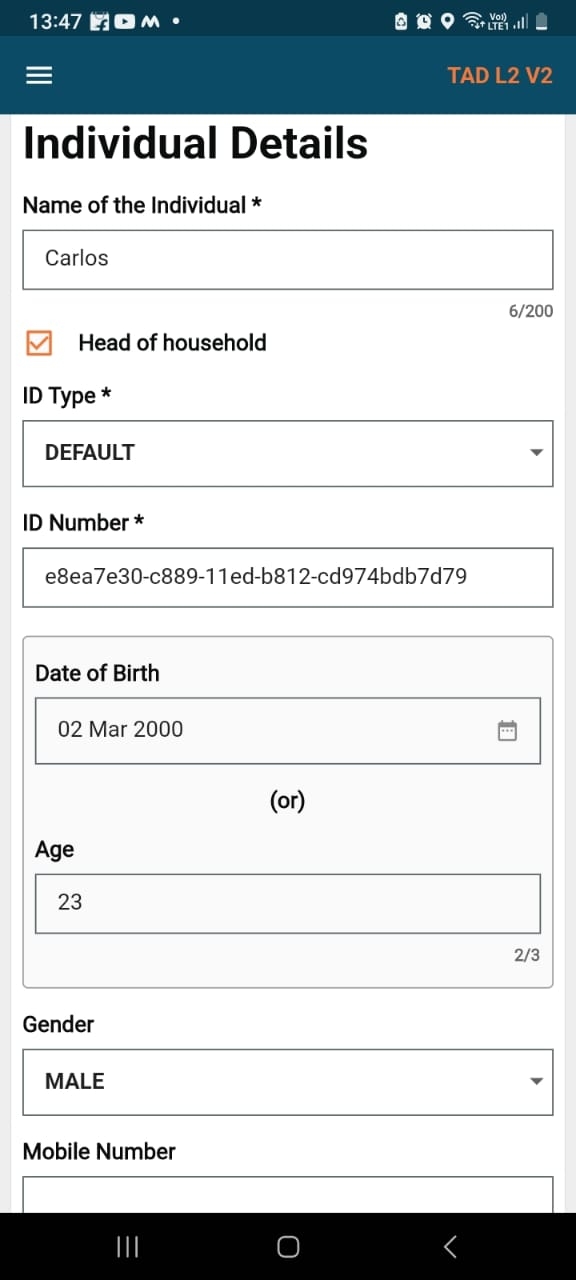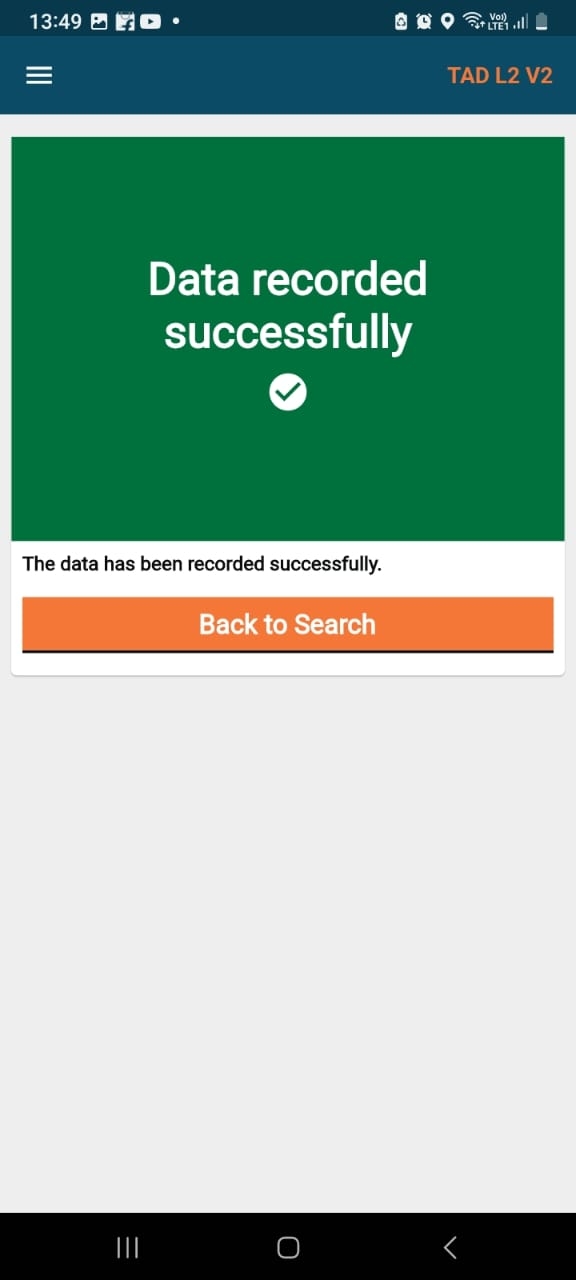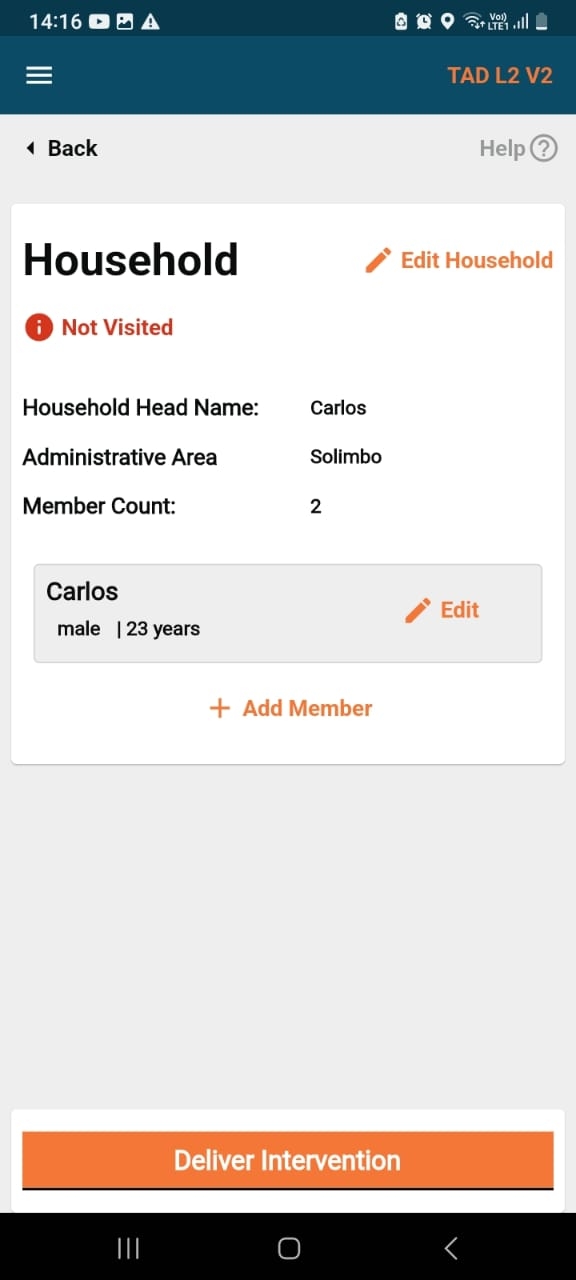Vector control is pivotal in global efforts to control and eliminate malaria. It is essential for reducing malaria transmission and ultimately halting its spread. Currently, the two primary vector control strategies are long-lasting insecticidal nets (LLINs) and indoor residual spraying (IRS), which together constitute nearly 60% of global investment in malaria control initiatives.
DIGIT HCM for IRS will empower stakeholders involved in the campaign to achieve their objectives seamlessly without disrupting their routine activities. It will facilitate real-time tracking and monitoring of campaign coverage and progress, enabling timely interventions. This will lead to improved campaign reach, enhanced efficiency for campaign workers, and cost savings through better management of inventory and operations.
User Role: Registrar
Home Screen:
This is the home screen for a registrar. You will see the following cards:
Beneficiary: For registration and spraying of households
Sync Data
File Complaint
Dashboard: View key metrics and visualisations
Search Households (Reuse of registry)
You can search for the households that are registered from previous campaigns before registering as a New Household. This page has 2 indicators:
Number of houses sprayed
Number of houses for revisits (closed/refused/ineligible)
There will be 2 filters for the search results:
Search by proximity
Filter for ‘Revisits’
a. The Revisits filter should also show the count in that filter
The households card will show the following additional information on top of what is already available in the product.
Number of pregnant women
Number of children
Number of rooms
By default, the "Register New Household" should be disabled and should be enabled only upon searching (3 chars minimum).
Household Location
The household details page will capture:
The village name (populated based on boundary selection)
Landmark (non-mandatory)
GPS coordinates and accuracy
There will be an info card that tells you to ensure the village name matches the actual one on the field.
Case 1: Reuse of registry
The date of registration should be as per Today’s date
The total number of members living in the HH should be populated from the registry and should be editable
The number of pregnant women in household needs input from the user
Number of children less than 5 years in HH needs input from the user
Info card to make sure the calculations are correct
Case 2: New registrations
The date of registration should be as per Today’s date
The total number of members living in the household needs input from the user
The number of pregnant women in a household needs input from the user
Number of children less than 5 years in household needs input from the user
Info card to make sure the calculations are correct
The edit household/delete household options are available on the household details page.
To capture:
Type of structure
No.of rooms in the house
The type of structure will have clickable cards that can be toggled to select/deselect.
Each type of structure should be tagged to a status:
Eligible
Ineligible
Once you capture the details, click on Next.
Individual Details
Case 1: New registrations
The individual details page will capture:
Name of the individual
Age
Gender
Mobile number
Once you capture all the details, click on Next.
Case 2: Reuse registry from previous campaigns/registrations: This page will be skipped.
This will provide a summary of all data captured so far. Check the details and click on Submit.
Confirmation Screen
It will ask for:
Submit
Cancel
Click on Submit if the correct details have been captured.
You will get a success message. You can click "View Household Details" to check the information.
You will see the following cards:
Beneficiary: For registration and spraying of households
Sync Data
File Complaint
Dashboard: View Key metrics and visualisations
Search Households
You will search for registered households to mark spray details. If a household is not registered and requires to be registered, you should be able to register them by clicking on "Register New Household".
This page captures if the IEC Mobilizer has visited the household or not. If the spray operator is recording data against an existing household, this will be the first screen they should see after searching and selecting the household. If the spray operator is creating a new household, then they will arrive at this screen after the registration flow is complete. Click on 'Yes' or 'No' to record if the IEC Mobilizer has visited the household. Next, click on 'Sprayed' or "Did Not Spray".
If you click on 'Sprayed' in the previous screen, the spray details will be captured, which includes:
The date of spraying
Total no.of rooms sprayed
Type of insecticide used
Check the details and click on Submit.
Success/Failure Screen
You will get a success message.
Spraying Not Done
If you selected "Did Not Spray", then this page should capture
The date of the visit
Reason for not spraying
The incompatible structure card should be auto-selected based on the household structure chosen at the registration flow.
Closed Households
The home screen has a separate icon for marking closed households. Clicking on the icon will take you to the Household details screen.
GPS coordinate
Village name
Coordinate accuracy
Household head name (Optional)
Clicking on Next will take you to the Summary screen.
Success/Failure Screen
You will see the success screen.
On revisits, when the user selects the filter ‘ ‘Closed’, all households with the status as closed should be shown in the results (Within the boundary selected). Opening any card should take the user to the normal flow of registration:
Household location → Household details → Individual details → IEC → Spray/non spray
The status needs to be updated from ‘Closed’ accordingly.
An illustrative guide to using the Single-Round Registration & Delivery module
This enables frontline workers to register households and individuals using the HCM application.
Register households
Add/Delete members to/from the households
Edit household/individual details
Delete household
Record delivery of an intervention
Frontline workers
Register households
Add members
Deliver intervention
SBCC
Provide direct healthcare services, communicate SBCC information, and support to communities. Usually operate in teams and within a specified boundary.
Field Supervisors
Train and monitor the field teams
Provide on ground support
May have authority for registration and distribution to support the teams
Organize and direct the activity of frontline staff in health initiatives. Offer direction, assistance, and coordination for effective service delivery, adherence to protocols, and high-quality results.
When field and district supervisors navigate to the home screen, the beneficiaries button is visible to them.
On this page, the following actions can be performed:
You can register a new household only after attempting a search.
Click on the "Register New Household" button to register a household.
After the user clicks on "Register New Household", the page navigates to the "Household Location" page.
The "Administrative Area" is the only mandatory field. "Address Line 1", "Address Line 2", 'Landmark' and "Postal Code" are optional fields.
Clicking on the 'Next' button will take the user to the "Household Details" page where the number of members living in the household can be registered.
Clicking the 'Next' button will take the user the "Individual details" screen.
The first individual added will be the "Head of Household" by default.
The name, ID type, and ID number fields are mandatory. You can enter the date of birth or their age. The date birth will take precedence over age.
When the user clicks on the submit button, a popup appears asking for confirmation.
If the user clicks on ‘Submit’, the household is registered and a confirmation screen is displayed.
The user can click on the "Back to Search" button for editing the household or register new household fields.
Click on the open card to navigate to the detailed page of the household.
There is an "Edit Household" button for editing household details, which navigates the user to the household location screen. The service delivery status is present below the household’s name followed by the administrative area and the number of members.
There are cards for each member, starting from the household head. The card consists of the ‘Edit’ button for individual-level actions.
For adding new members to the household, there is the "Add Member" button below the member cards, which navigates the user to the "Individual Details" screen.
At the bottom, the "Deliver Intervention" button is present which navigates the user to the update delivery screen.
Household Details
Edit/Delete Households
House Details
Summary
Success/Failure message screen
User Role: Spray Operator Home Screen:
IEC Details
Spray Details
On this screen, the following details can be captured:
On the summary screen, the details captured so far should be displayed. If the program allows, then you can scan a voucher and encode the details in the QR code. The voucher can then be affixed on the house for scanning during re-visit. The record created should be labeled with the status as ‘Closed’. Click on Submit.
HCM - Indoor Residual Spray (IRS)
Define the scope for the DIGIT HCM for managing IRS campaigns
Present the use-cases for IRS campaigns and the corresponding capabilities and features needed to cater to them
Present the mockup wireframes for the user interface
Estimate the changes/improvements needed in the DIGIT HCM to cater to IRS use cases in the frontend, backend, and registries
Define the indicators and visualisations for the dashboard for campaign supervisors
Vector control is the key intervention for global malaria control and elimination efforts. It is critical for the reduction and, ultimately, for the interruption of malaria transmission. Currently, the two most common vector control interventions are long-lasting insecticidal nets (LLINs) and indoor residual spraying (IRS). Together, these account for almost 60% of global investment in malaria control.
IRS is the application of a long-lasting, residual insecticide to potential malaria vector resting surfaces such as internal walls, eaves and ceilings of all houses or structures (including domestic animal shelters) where such vectors might come into contact with the insecticide. When carried out correctly, IRS is a powerful intervention to rapidly reduce adult mosquito vector density and longevity and, therefore, to reduce malaria transmission. The effectiveness of IRS as a malaria control intervention arises from the fact that many important malaria vectors are endophilic. That is, when searching for blood meals they enter human habitations or animal shelters where they rest on the walls, ceilings and other interior surfaces before or after feeding on the residents. When a vector comes into contact with a sprayed surface, it absorbs a lethal dose of insecticide, thereby reducing its lifespan. This results in a progressive decline in vector density and longevity, especially among older female mosquitoes, and a reduction in overall vectorial capacity, thereby contributing to a reduction in malaria transmission. IRS is most effective against indoor feeding (endophagic) and indoor-resting (endophilic) vectors.
One significant difference between the use of IRS and the use of treated mosquito nets is the point at which each intervention works to the greatest effect. IRS may provide a small amount of protection to an individual house by repelling and reducing the number of vectors that come into the house. However, the greatest impact of an IRS intervention takes place after feeding, when the anopheline mosquito is more likely to rest on a sprayed surface and pick up a lethal dose of insecticide, thus preventing it from going on to transmit the malaria parasite to others in the vicinity. This means that for IRS to be effective, there must be high coverage1 (usually > 85%) of all structures that are potential resting places to obtain the “mass effect” on the vector population: in other words, being the only sprayed house in the neighbourhood will do little to protect the residents. LLINs, however, inhibit feeding before the mosquito can inoculate the person with sporozoites, and the insecticide component of the net provides a degree of lethal effect on the
vector. This provides both personal protection and, at high coverage rates, a “mass effect” on the vector population. Therefore, being the only house in the neighbourhood with residents sleeping under a treated net will provide some degree of protection, even if the neighbours are not covered.
The various selection criteria for IRS are as follows:
IRS is a suitable form of vector control when:
The following sources/partners/activities were instrumental in developing the DIGIT HCM for the IRS use case:
WHO - IRS Operational manual
Discussions with Good Bye Malaria
Discussions with NMCP Mozambique
Field Study
A field study was conducted in the district of Machava of Maputo province to understand the different actors, their actions, needs, and pain points. Simulation of spraying for one household was done by a team of spray operator, mobilizer, and team lead.
DIGIT HCM for IRS will enable the various actors involved in the campaign to achieve their goals without hindering their routine activities and help to track and monitor the campaign coverage and progress and help to take appropriate interventions that leads to better campaign coverage, increased efficiency for campaign workers, and reduced costs due to beter management of inventory and operations.
This document covers only the use cases and features that are different or in addition to the existing DIGIT HCM. Modules such as warehouse management and supervision for which use cases are similar to the existing ones are excluded unless specified otherwise.
Primary Goals:
To reduce the vector’s lifespan to less than the time it takes for the malaria sporozoites to develop so that the vector can no longer transmit malaria parasites from one person to another
To reduce vector density by immediate killing, IRS can lead to the local elimination of important malaria vectors
To reduce human–vector contact through a repellent effect, thereby reducing the number of mosquitoes that enter sprayed rooms
The success of the product will be measured based on the following key metrics
App:
The SUS score from the UAT for the application
The average time taken to complete registration and spray details for a house
Total number of crashes observed across all users
Number of technical complaints generated by users about the application
Total number of stock transactions captured by warehouse managers
The average number of stock transactions made by warehouse managers in a day
Total number of times the supervisors made checklist entry
Average number of times a supervisor made checklist entry per day
Dashboard:
The SUS score from the UAT for the dashboard
The number of average active dashboard sessions per user
% of total supervisors who have used the dashboard at least once
Supervisors
Supervisors operate at various organisational hierarchies such as National, Provincial, and District. The primary function of supervisors is to ensure all the other actors are following the protocols and procedures. This is ensured using checklists.
Warehouse Managers
Similar to supervisors, warehouse managers also operate at various organisational hierarchy levels. Generally, warehouse managers manage the stock transactions across various warehouses situated at national, provincial, district, or locality levels.
Field Teams
The field team typically consists of 4-5 spray operators, helpers, team leads, and mobilizers. Team lead manages the on-ground operations and is also in charge of stock (insecticides and PPEs) distribution to the spray operators. The spray operators are in charge of registering and/or capturing the household and spraying data. The mobilizer visits households to convince the households to accept the spraying
Supervisors
Needs:
Effectively manage and monitor the progress of spraying operations;
Filling in essential forms for control and monitoring;
Visualize the progress of spraying operations, stock levels, campaign coverage and other relevant metrics on dashboards to make informed decisions about team management and operational strategies.
Pain points:
Challenges in collecting and compiling data in real-time;
Possible lack of communication between field supervisors, difficulties in solving problems in real-time during field operations;
The need to carry out data quality checks on a specific percentage of the operator files at each operational base, ensures the accuracy of the records.
Warehouse Managers
Needs:
Data management and warehouse targets;
Documentation and tracking of insecticide shipments;
Record daily stock transactions, from initial receipt to the end of the campaign, including daily withdrawals and returns;
Monitoring team performance and stock levels via dashboards to track operational efficiency.
Pain points:
Time-consuming manual checking processes, depending on human observation can be prone to errors, and potential security errors that can go unnoticed;
Challenges in carrying out manual checks and counts of equipment and inventory, which can result in discrepancies between actual and recorded physical stock;
Ensuring the safety of the warehouse on a daily basis during the campaign, reporting any anomalies that occur in order to maintain the integrity and safety of the materials.
Mobilizers
Needs:
Ensure that all communities have access to the necessary information about the spraying program and that this information is understood effectively, overcoming possible language or educational barriers;
Ensure that all families are aware of the impending spraying and are prepared to receive the Spray Operators.
Pain points:
Possible lack of access by communities to essential information about the program, making it difficult to understand the instructions;
Possible resistance or lack of understanding on the part of communities regarding the spraying programme, along with logistical challenges in organizing door-to-door visits;
Challenges in organizing and carrying out door-to-door visits to mobilize families and ensure their readiness to receive the Spray Operators.
Spray Operators
Needs:
An intuitive and easy-to-understand interface to make the application easier to use;
An effective search function to quickly locate registered houses based on geographical proximity or the name of the head of the house;
Ability to record the accurate receipt and return of insecticides and other materials using checklists in the app:
Tools to identify high-risk groups, such as pregnant women and children under the age of 5;
Access to a summary of recorded data for accuracy checks;
Ability to record all activities related to spraying, including quantity and type of insecticide used, to keep records of each intervention.
Pain points:
Lack of technical skills to operate the application, especially for those from rural areas or with little technological experience;
Risk of exposure to chemicals during the handling and application of insecticides;
Difficulty in carrying bottles and equipment needed to mix and apply insecticides;
Challenges in correctly following all Standard Operating Procedures (SOPs), which can affect the effectiveness and safety of the process;
Problems with the quality of recorded data, including data inflation errors or theft of materials.
Team Leads
Needs:
Visualize targets to effectively manage and monitor the progress of spraying operations;
Precise stock control;
Adequate distribution of insecticides;
Spray Quality Control;
A performance evaluation form for each team member;
Visualise the progress of spraying operations teams on dashboards, to promptly identify anomalies and areas of underperformance.
Pain points:
Difficulties in accurately tracking inventory;
Challenges in simultaneously monitoring several Rociators during operations;
Difficulties in optimizing routes for efficient coverage;
Problems with non-compliance with Standard Operating Procedures (SOPs);
Need to reconcile data in real-time with the time constraints of daily reconciliation, ensuring accuracy in logistical and operational records.
The document only covers the features that are in addition or changing with respect to the HCM application currently available for other campaign types.
1. Register a new household and capture details required for the IRS campaign
User persona: Mobilizer/ Registrar
Purpose: Register a new household and capture details required for IRS campaign. The following parameters are required to be captured:
Date of registration
Household location details (Address, GPS)
Household member details (Total number of people, pregnant women, children)
Household identify details (Household head name, age, gender)
Total number of rooms
Type of structure
2. Capture the spray details post-spraying
User persona: Spray Operator
Purpose: Capture the details of the spray after the spraying is done for a structure. The following parameters are required to be captured:
Date of spray
Number of rooms sprayed
Type of insecticide used
Type of spray (Primary/Secondary)
If the mobilizer visited the household?
Quantity of insecticide used per house (Out of Scope)
Time taken for spraying (Out of Scope)
Concentration of insecticide used (Out of Scope)
3. Track the time spent per household
User persona:
Registrar / Spray Operator / Mobilizer
Purpose: To measure if the registrar/spray operator/mobilizer is spending an adequate amount of time required to do the following tasks per house.
Tasks for a registrar/mobilizer:
Travel from the previous house to the current one (A)
SBCC communication required for acceptance of the spray (B)
Capturing the household and structure details (C)
Travel to the next house (D)
Total time spent =A+ B+C+D
Time spent for actual relevant task = B+C
Capturing time spent per house will help to evaluate if the mobilizer/registrar is spending sufficient time at each household delivering the key Social Behavioral Change Communication (SBCC) messages to the households
Tasks for a spray operator:
Travel from the previous house to the current one (A)
Preparation of house for spraying (B)
Preparation of insecticide solution (C)
Spraying the eligible structures (D)
Post-spray activities (cleaning, setting up the house, etc.) (E)
Entering the spray data in the application (F)
Travel to the next house (G)
The total time spent by a spray operator is the time spent for activities A to G. The time of interest is the time spent at a household which is B+C+D+E+F. The time spent only for spraying (D) is relevant however is out of scope for this release. For activities B to F, the coordinates captured will be more or less equal within 5-10 meters at any given time. For activities A and G, the coordinates captured will vary temporally.
Capturing the time taken at each household location will help to assess if the time spent per household is proportional to the number of rooms in a house. This is an indication of the efficiency of the spray operator as well if they are spraying all the rooms or not.
4. Filter the household search results
User persona:
Registrar/Spray Operator/Mobilizer
Purpose: For any campaign there are cases where multiple visits will be required for a household due to any of the following reasons:
House closed
House refused
The registrar/spray operator is required to register the households even if the above reasons hold true. This is done to estimate the number of households required for mop-up campaigns or revisits as well as their locations. During the 2nd visit, the registrar/ spray operator is only required to update the spray details against the previously registered households. To enable the user to identify households that need to be revisited quickly, it is required to add a status filter while searching for the household name. Using the filter in conjunction with the proximity search (available) will help to navigate to the households needing revisits.
5. Integration of IoT devices such as Goizper smartlight/wearable sensors that can capture spray details, GPS, etc.
This is being explored and is out of the scope for the current version
6. Track the performance of the team members in the application
User persona: Field team lead
Number of households sprayed for each spray operator
Average time taken by each spray operator to spray a house
Total time spent by each spray operator for spraying
% target achieved by each spray operator
Last synced time
The key performance indicators to track are:
Purpose: As a team lead, it is important to track key performance indicators and coverage indicators for each team member. This helps the team lead to reach out to the specific individual and instruct/assist them with course correction.
7. Capture the GPS location while filling out checklists
User persona: Supervisors
Purpose: The GPS location helps to evaluate if the supervisors are visiting the field operations and monitoring the campaign staff in the respective administrative hierarchy they are assigned to. The current checklist in DIGIT HCM needs to be enhanced for this.
8. Capture GPS location for stock management
User persona: Warehouse managers
Purpose: The GPS location helps to evaluate if the warehouse managers are making the stock entries at the respective warehouses that they are assigned to or not. It also helps to identify the temporary facilities that were built for the current campaign and build geocoded facility registries that can be used for future campaigns.
9. Capture Closed Households
User persona: Spray Operators
Purpose: The spray operators can visit the houses when it is closed. However, it is important to capture the location (GPS, address, boundary) of this household so that the campaign planners can plan resources and time for mop-up campaigns. They need to know how many houses were in all villages/districts to plan revisits. Also, the spray operators can plan their route based on the proximity search where the GPS coordinates captured in the first visit will help.
Why separate flow for Closed Households?
In HCM without the mandatory fields such as Household Head name, Location, Household details, etc, the record cannot be created in the registry. Hence this is a unique case compared to other scenarios such as ineligible where the household details can still be collected.
Field
Data Type
Data Validation
Mandatory/Not?
Comments
Name of Head of HH
Text field - String
Min. length= 3 characters
Max. length= 64 characters
Mandatory
Total no.of houses sprayed
Metric card Read only
Number
Mandatory
To follow comma separation
Total no.of revisits
Metric card Read only
Number
Mandatory
To follow comma separation
Village Name
String (Read only)
Mandatory
Auto populated from Master data. Non editable
Landmark
Text field - String
Min. length= 0 characters
Max. length= 64 characters
Non-mandatory
Lat
Numeric
Mandatory
Latitude of the household. Fetched by the system.
Long
Numeric
Mandatory
Longitude of the household. Fetched by the system.
Accuracy
Numeric
Mandatory
Accuracy of lat-long captured
Date
String (Read only)
Must display the current date
Mandatory
Displays the date of registration
Total no. of members living in the household
Counter
Min = 1
Max = 20
Mandatory
Increment counter
No.of pregnant women in the household
Counter
Min = 0
Max = 10
Mandatory
Increment counter
No.of children less than 5 years in the household
Counter
Min = 0
Max = 20
Mandatory
Increment counter
Type of structure
Selection card
Select only one
Mandatory
No. of rooms in the house
Counter
Min = 1
Max = 20
Mandatory
Increment counter
Name of the individual
Text field - String
Min. length= 0 characters
Max. length= 64 characters
Mandatory
Age
Number field
Min = 1
Max 150
Mandatory
Auto populated
Can edit
Gender
Radio button
Male
Female
Other
Mandatory
Auto populated
Can edit
Mobile Number
Number
9 digits
Non Mandatory
IEC visited or not?
Selection card
Yes/No
Mandatory
Date of visit
String (Read only)
Must display the current date
Mandatory
Displays the date of visit for spraying
No.of rooms sprayed
Counter
Min = 1
Max = 20
Should be <= to the total no.of rooms
Mandatory
Increment counter
Insecticide used
Selection card
Single select
Mandatory
Reason for non-spray
Selection card
Reasons:
Multiselect
Mandatory
Multi select.
Ineligible card should be auto selected if the type of structure is not compatible
1. Register a new household and capture details required for the IRS campaign
a. Able to register new households by capturing the following data elements - Happy path
Date of registration
Household location details (Address, GPS)
Household member details (Total number of people, pregnant women, children)
Household identify details (Household head name, age, gender)
Total number of rooms
Type of structure
b. Able to mark households as closed after capturing only the following data - Unhappy path
Date of registration
Administrative hierarchy
Household GPS
Placeholder for household head name
i. Can be auto-filled with a template name (eg: “Closed household”) if the household is marked as closed
c. Able to register a new household, submit the record, sync the record, and search the registered household with the household head name
d. Able to view registered households nearby based on proximity search
e. Able to sort the registered households based on the following filters
Closed
f. Capture GPS at regular intervals (every 5 minutes) and compute the time spent at each household
g. The registration module can be assigned to specific roles without the spraying module and should work independently
h. Able to down sync the registration data for a specific boundary
Statuses
The following statuses are valid for each household:
Not Visited
Registered
House closed
Refused
Ineligible
Sprayed
Not visited → For households enumerated in previous campaigns such as bednet/SMC but not yet visited for the IRS campaign.
Registered → Households that were registered as part of the IRS campaign
House closed → Households that were found closed during the registration or the spraying
Ineligible → Houses that were built with materials not compatible with IRS
Refused → Houses that were registered but refused for spraying
Sprayed → Houses that were registered and underwent successful spraying
The statuses will move across as follows:
Not visited →
(Registered / House closed) →
(Sprayed / Refused / House closed / Ineligible)
Only households with the status ‘Registered’ will be able to go through the spraying process and record spaying details against them.
2. Capture the spray details post-spraying
a. Ability to register a new household with the data fields mentioned above -
b. Able to mark households as closed after capturing only the following data - Unhappy path
Date of registration
Administrative hierarchy
Household GPS
Placeholder for household head name
i. Can be auto-filled with a template name (eg: “Closed household”) if the household is marked as closed
c. The spray operator should be able to capture only the spray details against an already registered household
d. The spaying module should work independently to the registration module
e. Both the registration and spraying modules can be stitched together back to back depending on the program requirements (eg: Mozambique IRS)
f. The spray operator should be able to down sync the registration data for a specific boundary
g. The spray operator should be able to search for registered households with household head name
h. Ability to view registered households nearby by proximity search
i Ability to filter the registered households by the following statuses
a. Closed
b. Refused
j. The filter and proximity search to function independently as well as in combination k. Ability to capture the following data fields for successful spraying - Happy path
Date of spray
Number of rooms sprayed
Type of insecticide used
Type of spray (Primary/Secondary)
If the mobilizer visited the household
Quantity of insecticide used per house (Out of Scope)
Time taken for spraying (Out of Scope)
Concentration of insecticide used (Out of Scope)
l. Ability to update the status of households to the following
Refused
Closed
Ineligible
m. Able to mark already registered households as ‘Closed’
n. API endpoints to integrate with data from IoT devices in the future
3. Track the time spent per household
a. Track coordinates of the spray operators/mobilizers/registrars at regular intervals (5 minutes)
b. The interval time should be configurable depending on program requirements
c. Compute the time spent at each household GPS coordinate (where there is relatively no movement of coordinates)
d. The total time taken by each user and the average time taken by each user to be tracked in the dashboard (DSS) as well as the Team lead (Mobile dashboard)
e. This should be captured in the background and also in offline mode without any user action needed
f. The time tracking should start and end at a specified time of the day and should be configurable for different implementations
4. Filter the household search results
a. The household search results should be able to be filtered based on different statuses
b. The filters should be able to be configured for different roles. For eg: a registrar should be able to see only the filter ‘Closed’ whereas a spray operator should be able to view the filters ‘Refused’ and ‘Closed’
c. The filters should work seamlessly without any lags
d. The filters should work seamlessly along with the proximity search as well as without the proximity search
5. Integration of IoT devices such as Goizper smartlight/ wearable sensors that can capture spray details, GPS, etc. This is being explored and is out of the scope for the current version
6. Track the performance of the team members in the application
a. Able to view the aggregates of team performance as well as individual team member performance in the application
b. Able to view the team indicators in near real-time provided the teams as well as team leads have internet connectivity
c. The key performance indicators to track are:
Number of households sprayed for each spray operator
Average time taken by each spray operator to spray a house
Total time spent by each spray operator for spraying
% target achieved by each spray operator
Last synced time
d. The indicators are to be updated automatically without any action required from the team lead based on the upsync of data from the teams
7. Capture the GPS location while filling out checklists
a. Capture the GPS location for each checklist filled
b. The GPS is to be captured in the backend without any action by the user
c. The coordinates captured need to be shown in the dashboard
8. Capture GPS location for stock management
a. Capture the GPS location for each stock transaction
b. The GPS is to be captured in the backend without any action by the user
c. The coordinates captured need to be shown in the DSS
9. Capture Closed Households
a. Capture the following details for a closed household:
GPS coordinates
Date and time of record creation
Village/Lowest level of boundary
Name of Household head (This can be made optional and can be made mandatory based on the implementation requirements)
Voucher scanning (This should be made customizable at the implementation level since not all countries will have a voucher-based campaign)
When revisiting the house, the house details should be listed by proximity calculated based on the GPS coordinate captured. The name of the household head should be displayed if it was captured.
The status of such household records created should be marked as ‘Closed’
Performance:
The battery consumption of the device with the addition of time tracking needs to be comparable to the current version of DIGIT HCM
The data consumption should be comparable to the current version of DIGIT HCM
The memory storage and usage should be comparable to the current version of DIGIT HCM
The data download and aggregation from the team members' mobiles to the team leads’ mobile should be seamless to have near real-time visibility of the key indicators provided there is internet connectivity
The application should work offline and also in the background to capture the coordinates at regular intervals
Usability:
Intuitive interface suitable for people with limited mobility, limited smartphone, and feature phone proficiency.
The following new components need to be built to enable this:
Box selection for choices (instead of radio buttons) - P0
Help text beneath each data capturing field explaining how to fill those fields - P0
Images/figures for each screen that summarises the action/data fields in those screens - P1
Voice-enabled search - P2 (to test)
A progress bar that shows pages completed and pages yet to complete - P2
The following design aspects need to be considered.
No drop-down fields unless the selection list is more than 5 - P0
No/limited open text fields
No vertical scrolls - P1
Not more than 2 data fields per screen - P1




